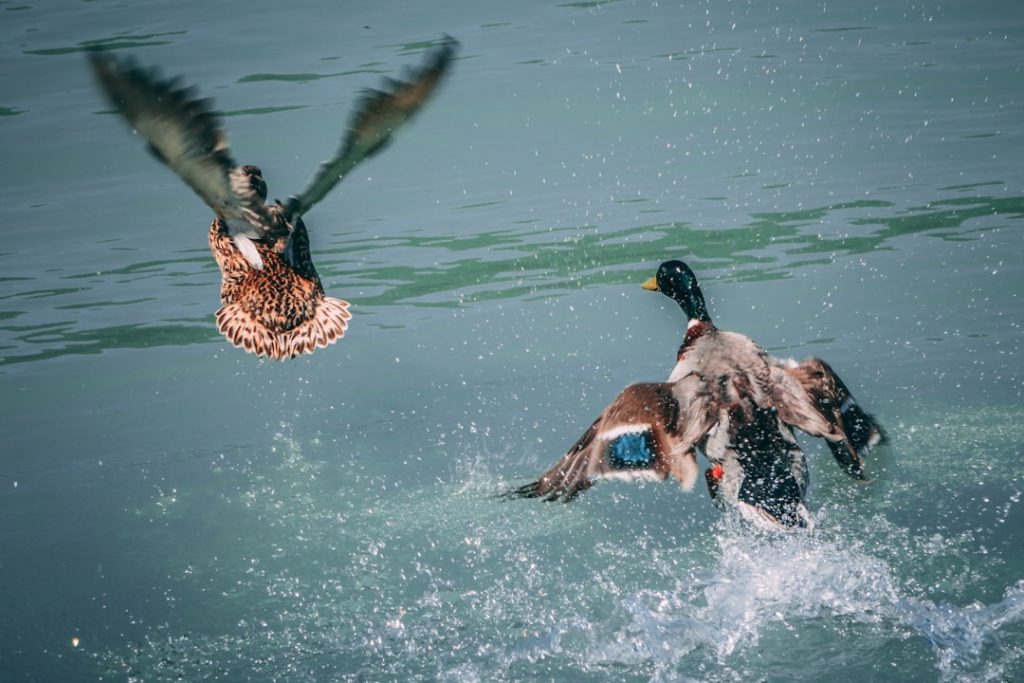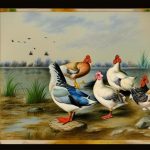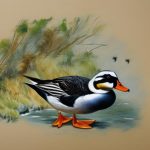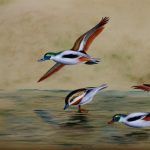Diving duck breeds are a fascinating group of waterfowl known for their unique diving behavior while foraging for food. These ducks are equipped with specialized adaptations that allow them to dive underwater in search of aquatic plants, invertebrates, and small fish. Diving ducks are found in a variety of habitats, including freshwater lakes, rivers, and coastal areas. They are known for their strong, streamlined bodies and powerful webbed feet, which make them excellent swimmers and divers. Diving duck breeds are a diverse group, with a wide range of species found around the world, each with its own unique characteristics and behaviors.
Table of Contents
Key Takeaways
- Diving duck breeds are known for their ability to dive underwater in search of food, with specialized adaptations for swimming and diving.
- Common characteristics of diving duck breeds include a streamlined body, webbed feet, and a strong, pointed bill for catching and eating aquatic prey.
- Popular diving duck breeds include the Canvasback, Redhead, and Greater Scaup, each with unique physical and behavioral traits.
- Diving duck breeds are typically found in freshwater habitats such as lakes, rivers, and marshes, where they feed on aquatic plants, invertebrates, and small fish.
- Conservation efforts for diving duck breeds focus on protecting their natural habitats, reducing pollution, and regulating hunting to ensure sustainable populations.
Common Characteristics of Diving Duck Breeds
Diving duck breeds are known for their distinctive physical characteristics that set them apart from other types of ducks. One common feature among diving ducks is their relatively short, stubby bodies, which are well-suited for diving and swimming underwater. Their legs are set farther back on their bodies, which helps them propel themselves through the water with ease. Diving ducks also have large, powerful webbed feet that act like paddles, allowing them to navigate through the water with agility. Another characteristic of diving ducks is their waterproof feathers, which help keep them dry while diving and swimming. These feathers are coated with natural oils that repel water, allowing the ducks to stay buoyant and warm in cold water. Additionally, diving ducks have strong, hooked bills that are adapted for catching and holding onto prey while underwater.
In terms of behavior, diving duck breeds are known for their impressive diving abilities. These ducks can dive to impressive depths in search of food, using their powerful legs and feet to propel themselves underwater. They are also skilled at catching fast-moving prey, such as fish and invertebrates, using their agile swimming abilities and sharp bills. Diving ducks are also known for their migratory behavior, with many species traveling long distances between their breeding and wintering grounds. During the breeding season, diving ducks can be found nesting near water, often in dense vegetation or on floating platforms. Overall, diving duck breeds are well-adapted to their aquatic lifestyle and have a number of unique characteristics that set them apart from other types of waterfowl.
Popular Diving Duck Breeds
There are several popular diving duck breeds that are well-known among birdwatchers and waterfowl enthusiasts. One of the most iconic diving duck breeds is the common loon (Gavia immer), which is known for its haunting calls and striking black-and-white plumage. The common loon is a skilled diver and can stay underwater for extended periods of time while hunting for fish. Another popular diving duck breed is the tufted duck (Aythya fuligula), which is found in Europe and Asia. The tufted duck is known for its distinctive tuft of feathers on the back of its head and its striking black and white plumage. This species is a proficient diver and can often be seen diving for food in freshwater lakes and ponds.
The greater scaup (Aythya marila) is another well-known diving duck breed that is found in North America and Eurasia. This species is known for its blue bill and yellow eyes, as well as its habit of diving for food in coastal waters and inland lakes. The greater scaup is a strong swimmer and diver, capable of reaching impressive depths while foraging for aquatic plants and invertebrates. Other popular diving duck breeds include the red-breasted merganser (Mergus serrator), the canvasback (Aythya valisineria), and the common goldeneye (Bucephala clangula). Each of these species has its own unique characteristics and behaviors that make them popular among birdwatchers and wildlife enthusiasts.
Habitat and Behavior of Diving Duck Breeds
Diving duck breeds can be found in a wide range of habitats, including freshwater lakes, rivers, coastal estuaries, and open ocean waters. These ducks are well-adapted to their aquatic lifestyle and can be found in both saltwater and freshwater environments. Diving ducks are often seen diving for food in shallow waters, using their powerful legs and feet to propel themselves underwater. They are skilled at catching fast-moving prey, such as fish and invertebrates, using their sharp bills and agile swimming abilities.
During the breeding season, diving duck breeds can be found nesting near water, often in dense vegetation or on floating platforms. They build their nests close to the water’s edge to provide easy access to food for their young. After the breeding season, many diving duck species migrate to warmer wintering grounds, where they can find an abundance of food in milder climates. Some species travel long distances between their breeding and wintering grounds, making impressive migrations across continents.
In terms of behavior, diving duck breeds are known for their impressive diving abilities. These ducks can dive to impressive depths in search of food, using their powerful legs and feet to propel themselves underwater. They are also skilled at catching fast-moving prey, such as fish and invertebrates, using their agile swimming abilities and sharp bills. Overall, diving duck breeds are well-adapted to their aquatic lifestyle and have a number of unique characteristics that set them apart from other types of waterfowl.
Conservation Efforts for Diving Duck Breeds
Diving duck breeds face a number of threats to their survival, including habitat loss, pollution, hunting, and climate change. Many species of diving ducks rely on specific habitats for breeding, feeding, and wintering, making them particularly vulnerable to habitat destruction and degradation. Pollution from agricultural runoff, industrial waste, and oil spills can also have a detrimental impact on diving duck populations by contaminating their food sources and nesting areas.
Hunting is another significant threat to diving duck breeds, as many species are targeted by hunters for sport or food. While hunting regulations and conservation efforts have helped protect some diving duck populations, illegal hunting continues to pose a threat to these birds in many areas. Climate change is also a major concern for diving duck breeds, as rising temperatures and sea levels can alter their habitats and disrupt their migratory patterns.
Conservation efforts for diving duck breeds include habitat protection, pollution control, hunting regulations, and climate change mitigation. Many organizations work to protect important wetland habitats that are crucial for diving duck populations during the breeding season and migration. Efforts to reduce pollution from agricultural runoff, industrial waste, and oil spills can also help protect diving duck populations by preserving their food sources and nesting areas.
Hunting regulations play a crucial role in protecting diving duck populations by establishing limits on hunting seasons and bag limits for hunters. These regulations help ensure that diving duck populations remain sustainable and healthy for future generations. Finally, efforts to mitigate climate change through reducing greenhouse gas emissions and protecting important habitats can help safeguard diving duck populations from the impacts of a changing climate.
Diving Duck Breeds in Captivity
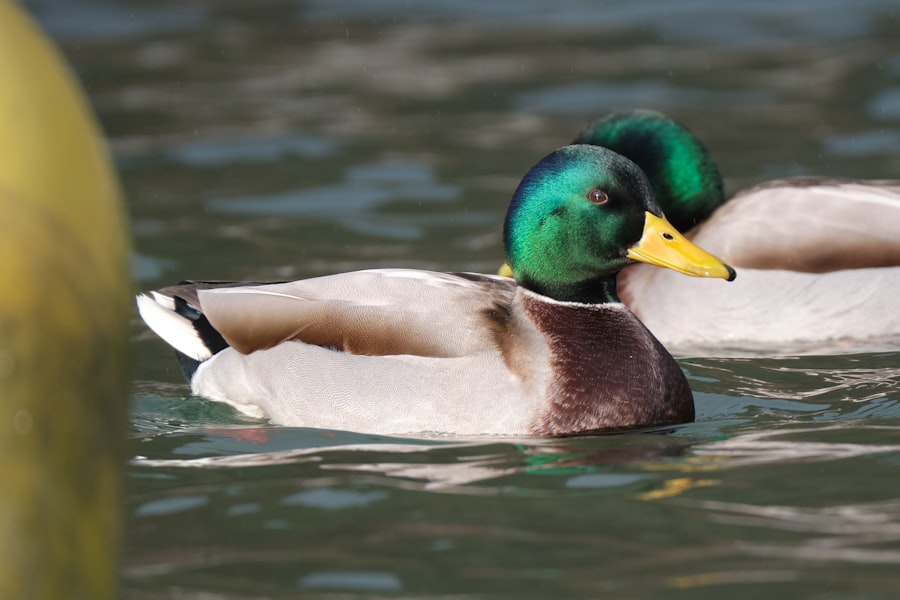
Diving duck breeds are popular attractions in zoos, wildlife parks, and aviaries around the world. Many species of diving ducks are kept in captivity for educational purposes and conservation breeding programs. Captive breeding programs play an important role in safeguarding endangered diving duck populations by maintaining genetically diverse captive populations that can be used for reintroduction efforts in the wild.
In captivity, diving ducks require access to large bodies of water for swimming and diving, as well as ample space for nesting and raising their young. They also require a diet that closely resembles their natural food sources in the wild, including aquatic plants, invertebrates, and small fish. Captive diving ducks also benefit from enrichment activities that mimic their natural behaviors, such as diving for food, preening their feathers, and building nests.
Conservation breeding programs for diving duck breeds aim to maintain genetically diverse captive populations that can be used to bolster wild populations through reintroduction efforts. These programs often involve carefully managed breeding pairs that are selected based on genetic diversity and compatibility. The offspring produced through these programs can be released into suitable habitats in the wild to help bolster wild populations that may be struggling due to habitat loss or other threats.
The Importance of Protecting Diving Duck Breeds
Diving duck breeds play a crucial role in aquatic ecosystems around the world by helping control populations of aquatic plants and invertebrates while providing food for other predators. These birds are also important indicators of the health of wetland habitats, as they rely on clean water and abundant food sources for their survival. Protecting diving duck breeds is essential for maintaining healthy wetland ecosystems that benefit a wide range of plant and animal species.
Conservation efforts for diving duck breeds are crucial for safeguarding these birds from the numerous threats they face in the wild, including habitat loss, pollution, hunting, and climate change. By protecting important wetland habitats, reducing pollution, regulating hunting practices, and mitigating climate change, we can help ensure a bright future for diving duck populations around the world.
In conclusion, diving duck breeds are fascinating waterfowl with unique characteristics and behaviors that make them well-suited to their aquatic lifestyle. By working together to protect these birds and their habitats, we can help ensure that future generations have the opportunity to appreciate these remarkable creatures in the wild.
If you’re interested in diving duck breeds, you may also want to explore the best coop options for chickens. Poultry Wizard offers a comprehensive guide on “What Kind of Coop is Best for Chickens,” which provides valuable insights into creating a suitable and comfortable living space for your feathered friends. Understanding the importance of a well-designed coop can enhance the overall well-being and productivity of your poultry. Check out the article here to learn more about creating an ideal environment for your chickens.
FAQs
What are diving duck breeds?
Diving duck breeds are a group of ducks that are known for their ability to dive and swim underwater in search of food. These ducks have adapted to foraging in deeper water and have specialized physical characteristics to aid in diving.
What are some common diving duck breeds?
Some common diving duck breeds include the Canvasback, Redhead, Ring-necked duck, Greater Scaup, Lesser Scaup, and the Common Goldeneye. These breeds are known for their diving abilities and are often found in freshwater lakes, rivers, and coastal areas.
What physical characteristics do diving duck breeds have?
Diving duck breeds typically have a streamlined body, webbed feet set further back on their bodies, and a more buoyant body compared to dabbling ducks. These physical adaptations allow them to dive and swim underwater more effectively.
What do diving duck breeds eat?
Diving duck breeds primarily feed on aquatic plants, insects, small fish, and crustaceans. They use their diving abilities to forage for food in deeper water, where they can access a wider variety of prey compared to dabbling ducks.
Where can diving duck breeds be found?
Diving duck breeds can be found in a variety of habitats, including freshwater lakes, rivers, marshes, and coastal areas. They are often migratory and can be found in different regions depending on the time of year.
Meet Walter, the feathered-friend fanatic of Florida! Nestled in the sunshine state, Walter struts through life with his feathered companions, clucking his way to happiness. With a coop that’s fancier than a five-star hotel, he’s the Don Juan of the chicken world. When he’s not teaching his hens to do the cha-cha, you’ll find him in a heated debate with his prized rooster, Sir Clucks-a-Lot. Walter’s poultry passion is no yolk; he’s the sunny-side-up guy you never knew you needed in your flock of friends!

